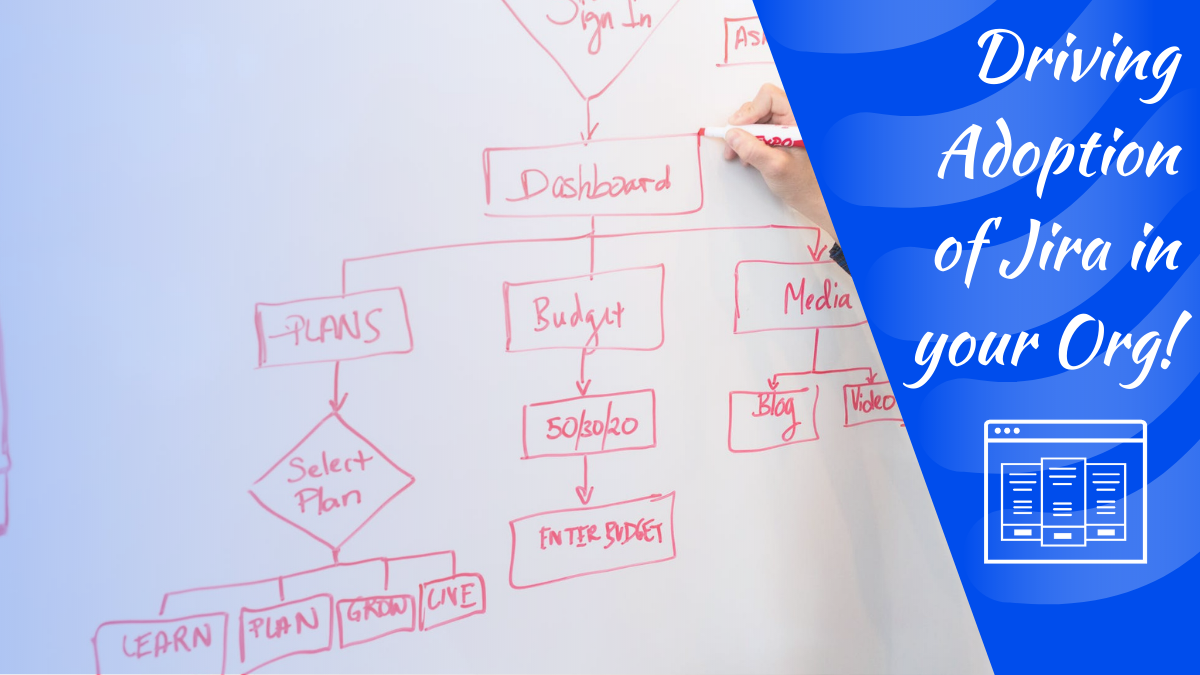It is pretty understood that Jira grows from the bottom up at most organizations. First, a team adopts it for their work management, then another team, then another. Eventually, it becomes someone’s job to manage it full time, or someone is brought in. And boom. Jira.
But what happens when the decision to adopt Jira comes from the top down? What complications occur there? And how can we drive it to be successful?
That is precisely the problem one reader contacted me about this week.
Hi,
All best in the new year! I need some help with my current job and wondered whether you would be able to help. I have been working with Jira as an admin/consultant/project manager for three years now and have just started in a new role.
The company I have just joined is attempting to change. To become more structured with the way they work and be more agile. Part of this is rolling out Jira across the board. This effort is why I have been hired.
Some issues I am faced with are:
-Extremely non-technically proficient users
-(Overly) Complex organization and process
-Resistance to change/Political Environment
-Leadership does not really grasp the scope of the change and that using Jira tooling does not suddenly make everything agile.
I consider myself an expert in terms of configuring, using, and administering Jira. However, the possible scale of the task is starting to daunt me (although I also am very motivated by the challenge and helping this company get itself organized and bring it into the 21st Century!). So, I guess I wanted to ask you for any practical insights you might have on any of this, perhaps from personal experience.
Well, flattery will get you everywhere. This reader has been given quite the challenge. However, their problem is hardly unique. Driving adoption can be difficult – especially when people have already been entrenched in their ideals. So today, we will look at practical advice and steps to make sure Jira grows in the company in an environment where it has been mandated rather than home-grown. So, let’s dig into this!
Take things one Team at a time.
Bringing an entire company into the Atlassian way of life can be daunting – even for me! There is so much that needs to be done, and you are only one person. This situation is where we fall back onto our training. First, subdivide the task, and then again and again until it can be divided no further. Then work on that subtask. In this case, focus on one Team at a time. Yes, there will be training and setup needed for each Team – but giving each Team individual attention will help them learn and start using the system. Once that Team is reasonably self-sufficient, you can move onto more of a support role and start with the next Team.
This method is the key to avoiding getting overwhelmed. If you try to do it all at once, well, you are just one person. You will likely not yet have the buy-in or influence to say you need help, so you have to make this work with what you’ve got. This process will also allow you to show progress while having each Team feel involved in their destiny.
Jira should slot into each Team with as little friction as possible.

This tip is key to battling the nay-sayers. Ideally, we would like to have as many teams on the same workflows, permission schemes, and field configurations as possible. But you are messing with how people make their living. That is going to stress anyone out. So be willing to listen to how each Team individually works, and show them you’re there to help, not disrupt them.
This point is also where you can try to make things smoother. The question “Why?” is going to be your friend here. If they are doing something that seems inefficient, ask why they are doing that. They will likely have an answer – and sometimes, it will be something you can automate away and save them time. Show them how using Jira won’t completely disrupt their lives but will make it easier when done right.
Also, understand that when people don’t like Jira, they likely don’t like it because of a bad experience. I’ve said it before, and I’ll say it again. Jira is infinitely configurable, which means there are infinite ways to mess things up and make it harder to use. So show them that you know the pitfalls and will guide them past that to an excellent configuration that helps rather than harms.
Have the Executive Team start using Jira for their direct teams.

The trick with moving one Team at a time is, well, it takes time! So you have to maintain goodwill and sponsorship while you work. The best way to do this is to have your Executive Team on Jira. This tip will accomplish several things.
First, the best way to learn any tool is to use it. One of the problems the reader stated is that Leadership doesn’t grasp the scope of change. But that Team in and of itself has work that has to be managed, too! So having them manage their work in Jira will help them understand what goes into using Jira, what it means to be Agile, and what you are trying to do with each time.
Secondly, it will endear you to the Executive Team, meaning you will have more time to achieve your goals. I mean, you paid so much attention to their needs, and you are doing so with everyone else at the company, right?
And lastly, it will put pressure on other Teams to adopt. If they see their Bosses Bosses Boss using Jira successfully…well, refusing to use it becomes a lot less appealing. Yes, it’s playing dirty, but if it achieves your goal of adoption, I think it’s fair.
However, there is a reason I put the advice about making Jira as hassle-free as possible right before this one. You are dealing with people who, right or wrong, view themselves as “very busy people.” They will need an especially frictionless process to even give it a shot. The onus will be on you to quickly prove that this will save them time and energy and make their teams run more efficiently. Do this, and you’re set. Failure is not an option. No pressure, right?
Find your Atlassian Allies within your company.
You’ll often find that in each organization, you will have just as many champions of Jira as you do nay-sayers. So you need to find these people. Hold events for them, get to know them and their Teams, and move them up the priority queue.
These people will help evangelize the solutions to their Team, thus making your life easier. So, how do you go about finding these people? One strategy I’ve found that works is to hold “Lunch and Learns.” Be clear that this is some Atlassian-related topic. Bring in speakers from the Atlassian community, have food if needed, and get to know why each person is there. Be sure to hold this on different days of the week so that people who couldn’t make one could make another.
No man is an island, so having these allies who are excited about your work and willing to help you is very much a key to a successful adoption campaign.
Education, Education, Education

Do you know my first blog posts were designed to help educate end-users to drive adoption? These posts are hidden now (I find them very cringe-worthy), but back before I started helping other Jira Admins, my original goal was to help people use Jira. This goes to my next point.
When you are in an organization new to Jira, you are as much a teacher as an Admin. You need to be holding events and webinars to teach people, have ALL the documentation in an easy-to-access place, and help people with some of the more difficult tricks and concepts. Sometimes this will be one-on-one help, and sometimes, you will be able to work with a Team as a whole. But if people don’t know Jira, they are more likely to make assumptions that will make your life harder.
This is especially true in an organization that might not be as tech-savvy as you. They are more likely to need help with the technology basics. Yes, this means sometimes you will have to go back to your helpdesk days and help them with simple things. But all this is with the goal to give them the knowledge they need to make the best use of the tools.
Constant Communication
You will want to be open about what you are doing and where you are in the adoption process. This fact means you will want to be sending out communications often. Have a weekly newsletter and use Confluence’s Blogs. Make sure no one has to ask, “What are you doing?” or “When will you get to my Team?” Keeping people up to date is vital in maintaining the goodwill to do what is needed.
Be sure to also boast about accomplishments, teams who are now using Jira, and success stories. You can also include highlights from the Atlassian community at large! Highlight every reason people should be using Jira, and you will be planting a seed that will lead to more adoption.
Have Metrics and a Dashboard to show Adoption Rates
Look, if it gets people using the tool, I’m willing to use every dirty trick in the book. This includes the “Fear of missing out” effect. So have a dashboard that shows how many people within the company are using Jira. Publish that information regularly. Not only will this help motivate you by showing how much you’ve already accomplished, but it will show others that they might be missing out.
This tip also ties into the point above about communication. You can include this dashboard in your weekly/biweekly newsletters so people can see that more and more – they are the minority. This method is a tool that becomes more effective the further along you get, so keep that in mind.
Get Feedback and Be Agile yourself.

This one is simple: Don’t assume you will have this process perfect right out of the gate. Instead, when you finish working with a Team, send out a survey to determine what they thought went great and what could be worked on. Getting feedback will help you iron out the wrinkles in the adoption process, making each subsequent Team adoption go more smoothly.
You can also use this to generate anonymized data to include in your communications. Get a great review? Ask them if you can reprint it, and if they say yes, include that in your newsletter. Use a graph to show how many people thought a team migration went well! You can use positive feedback to hype up the process.
Likewise, if someone has negative feedback, follow up directly with them. Find out if there is anything that can be improved, and let the user know that you’re there for the long haul to make sure they are taken care of! After adoption support can turn a negative perception into a positive one. The worst thing you can do with negative feedback is assume they are sour and let them go. This is why getting this feedback is so important. No matter what the users say, it gives you tools to improve things and make steps forward.
What do you think?
Do you have any adoption tricks and tips I didn’t mention? Or do you have your own nightmare stories? I want to hear both, so be sure to include them in the comments!
You can find my social media links on Linktree. You can also find links to donate to me directly, either by Paypal or Patreon. Any support you give goes towards making this blog better and increasing its reach to more Jira Admins, so it is appreciated.
You can also subscribe below to get new posts delivered to your inbox. I’m not joking when I say I often see the email before I see anything on social media, so it is the fastest way to see updates from the blog.
I will be live this evening on Youtube and Twitch, going over this week’s post in more detail and answering your questions. I had to take last week off due to a work meeting I couldn’t get out of, so I’m ready to be back. So I hope to hear from you there!
But until next time, my name is Rodney, asking, “Have you updated your Jira issues today?”

Incredibly powerful blog. I think this outlines many struggles admins go through on a regular basis. One thing I found incredibly powerful when being a one man band is training videos. Short 2 minute videos on everything across Jira. Creating/editing issues, workflows and using them Boards, JQL (always a big topic). But since we cannot be everywhere having decent videos which we can share with the wider community can often put some peoples mind at ease.
LikeLiked by 1 person
🤦♂️ How did I not think of videos! It seems obvious in hindsight, but never crossed my mind. Great advice, thank you!
LikeLiked by 1 person